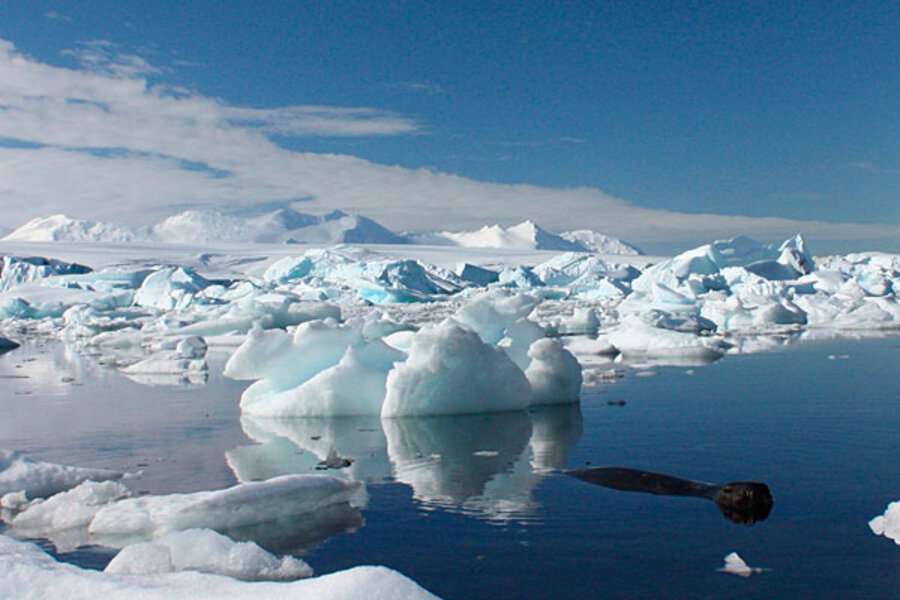Ice age study delivers blow to global-warming skeptics
Loading...
Rising levels of carbon dioxide drove much of the global warming that thawed Earth at the end of the last ice age.
That's the conclusion a team of scientists has drawn in a new study examining the factors that closed the door on the last ice age, which ended about 20,000 years ago.
The result stands in contrast to previous studies that showed temperatures rising ahead of increases in atmospheric CO2 levels. This has led some skeptics of human-triggered global warming to argue that if warming temperatures came first, CO2 wasn't an important factor then and so can't be as significant a factor today as most climate scientists calculate it to be.
The measurements from the previous studies were taken from ice cores extracted from thick glaciers in Antarctica. The new work supplements that data with temperature evidence from 80 locations around the globe.
The results show that while temperature increases around Antarctica appear to have led increases in atmospheric CO2, the picture globally was the opposite – CO2 increases paved the way for temperature increases.
“The new work is a significant advance” in the study of the climate conditions surrounding Earth's cycle of ice ages, notes Richard Alley, a Penn State University geologist who specializes in studying glaciers and the climate records encoded in the ice.
It's the latest indication that researchers' understanding of CO2's effects on climate “is confirmed by the history of climate,” he writes in an e-mail.
The results also hold notes of caution for today, notes Jeremy Shakun, a climate researcher at Harvard University in Cambridge, Mass.
He notes that during the 10,000 years from the end of the last ice age to the beginning of the current “interglacial” climate, atmospheric CO2 concentrations rose 40 percent, from 180 molecules per million in the atmosphere to 260 parts per million. During the past 100 years, concentrations have risen 34 percent, from 292 ppm to 392 ppm – and continue to rise.
“Clearly, it's not a small amount,” says Dr. Shakun, referring to the increases during the past century. “Rising CO2 at the end of the last ice age had a huge effect on global climate. We've raised it as much in the last century.”
That doesn't mean the full impact of these increases will appear during the course of this century, he explains. It takes much longer for the climate system to fully respond. The oceans are intercepting much of the current warming and additional CO2 humans have added to the atmosphere through burning fossil fuels and land-use changes. And Earth still hosts enormous ice sheets in Greenland and over Antarctica to keep things relatively cool.
“It will take many centuries and beyond to fully feel the effects,” Shakun says.
The international team, led by Shakun and Oregon State University paleoclimatologist Peter Clark, based its work on the chemical makeup of air samples contained in bubbles trapped in ice cores. Ice records from Antarctica go back some 800,000 years.
But the researchers also drew temperature information from 80 locations around the globe, spanning northern and southern hemispheres. Sources to track temperature changes over time ranged from microfossils in deep-ocean sediments to pollen trapped in sediments in freshwater lakes.
The team's results show that the initial trigger for warming to end the last ice age was a periodic change in the angle of Earth's tilt and in the orientation of its axis. This brought more sunlight to warm northern latitudes. As mile-thick ice sheets covering vast areas of the northern hemisphere's continents began to melt, fresh water poured into the oceans, particularly into the North Atlantic, changing mechanisms that governed the climate.
Sea levels rose five to 10 meters within a few hundred years, and the Atlantic's deep-ocean “conveyor belt” slowed. Typically, the conveyor pulls warm surface water north from the tropics to cool, sink, and move south along the bottom as colder water. But the added fresh water from melting ice sheets slowed the conveyor, cooling the north and warming the southern ocean, which reaches Antarctica.
The warmer waters in the southern ocean reduced the extent of sea ice around the continent, leaving more surface water exposed to exchange gases with the atmosphere. Changing wind patterns from the warming increased the pace at which CO2-rich water deep in the ocean welled up and vented CO2 into the atmosphere.
In essence, where today's CO2 comes from vast reservoirs of carbon stored underground as coal, oil, and natural gas, or as methane trapped in polar permafrost, the reservoir of carbon CO2 introduced during the end of the ice age initially came from stores deep in the ocean.
Climate scientists' historical attempts to understand the processes that ended past ice ages have laid the groundwork for the current understanding of how CO2 influences the climate.
As far back as 1896, Swedish physicist Svante Arrhenius published a paper in the Philosophical Magazine and Journal of Science that he hoped would help solve the climate riddle ice ages presented. The 38-page paper included painstakingly handwritten calculations – arguably the first global climate model – that estimated the climate's sensitivity to changes in CO2 levels. Remarkably, he reached a figure comparable to the one scientists today see as the most-likely value.







